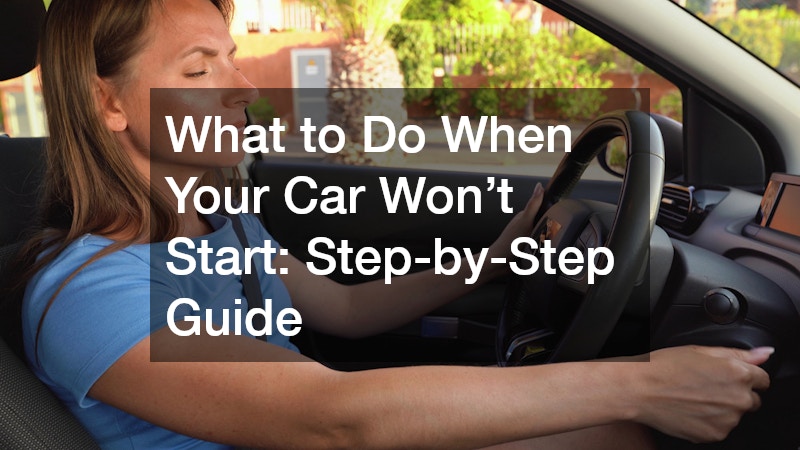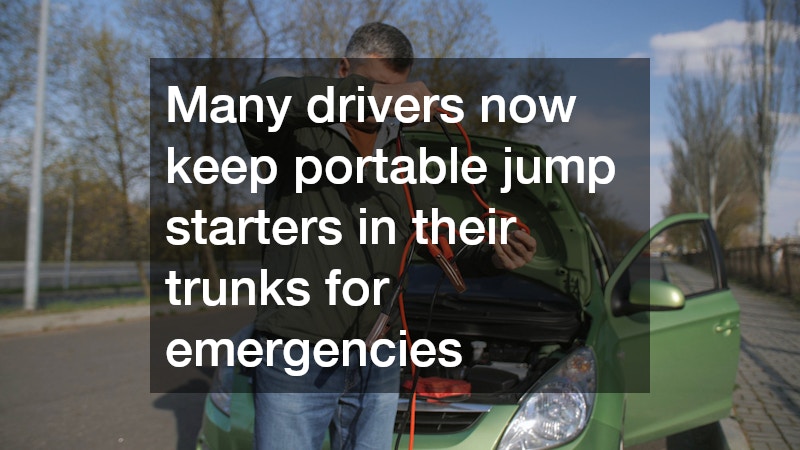-
Safety comes first. Always assess your surroundings, turn on hazard lights, and ensure you’re visible before attempting to troubleshoot a car that won’t start.
-
Rule out simple issues. Check for obvious problems like an empty gas tank, loose battery cables, shifter position errors, or a weak key fob battery.
-
Listen for warning signs. Clicking, slow cranking, silence, or an engine that turns but won’t start can point to different underlying issues.
-
Attempt a safe jump start. Use jumper cables or a portable jump starter if available, but if you’re unsure, call a tow truck service that offers roadside battery jump starts.
-
Know when to get professional help. If a jump doesn’t work or you’re in an unsafe location, roadside assistance is the best option for diagnosis and towing.
-
Understand common causes. Dead batteries, alternator failure, bad starters, ignition switch issues, or fuel system problems are the most frequent culprits.
-
Plan for the future. Regular battery checks, clean connections, avoiding unnecessary drain, and keeping roadside assistance coverage will reduce the chances of being stranded again.

Few situations are more stressful than turning your key—or pressing your start button—only to be met with silence or a weak click. A car that won’t start can derail your schedule, leave you stranded, and even put you in a dangerous situation depending on where you’re located. While modern vehicles are generally reliable, batteries, starters, and other systems can still fail at the worst possible times.
This comprehensive guide walks you through what to do when your car won’t start, with clear steps for troubleshooting, safety, and when to call a tow truck service that offers roadside battery jump starts. By the end, you’ll know how to react calmly and efficiently whether you’re at home, in a parking lot, or on the side of the road.
Step 1: Stay Calm and Assess Your Surroundings
The first and most important thing is your safety.
-
Check your environment. Are you in a well-lit, safe location like your driveway, or are you on the shoulder of a busy highway?
-
Turn on your hazard lights. This alerts other drivers that you’re experiencing trouble.
-
Move the car if possible. If your car stalled rather than failing to start, shift it to a safe area before trying again.
-
Stay visible. If it’s nighttime, wear reflective gear or use a flashlight to make yourself noticeable.
Your immediate surroundings should always be evaluated before focusing on the car itself. No troubleshooting is worth risking your personal safety.
Step 2: Look for Obvious Issues
Before calling for help, check for simple problems that may explain why the car won’t start.
-
Out of fuel. It may sound obvious, but sometimes a low fuel gauge or misreading the display is the culprit.
-
Loose cables. Open the hood and check the battery terminals. Corrosion or loose clamps can block electrical flow.
-
Key fob battery. For push-to-start cars, a weak or dead key fob battery can prevent ignition. Try holding the fob against the start button.
-
Shifter position. Ensure the gear is fully in “Park” (or “Neutral” for manuals).
-
Lights left on. Headlights or interior lights left overnight often drain a battery completely.
These quick checks can save you time and money if the issue is minor.
Step 3: Listen for Clues
Your car often gives signals about what’s wrong. Pay attention to the sounds—or lack thereof—when you attempt to start it.
-
A clicking noise: Usually means the battery is too weak to turn the starter.
-
Cranking slowly: Indicates a dying battery or a failing alternator.
-
No sound at all: Could be a dead battery, faulty ignition switch, or a wiring issue.
-
Engine turns but won’t start: May point to fuel delivery or spark problems.
This information will be valuable to both you and a technician if you call for assistance.
Step 4: Try a Safe Jump Start

If the signs suggest a dead battery, a jump start may be the solution.
Using Jumper Cables
If you have another vehicle available and a set of cables:
-
Park the helper vehicle nose-to-nose with your car, making sure both are turned off.
-
Connect the red clamp to the positive terminal of the dead battery.
-
Attach the other red clamp to the positive terminal of the working battery.
-
Connect the black clamp to the negative terminal of the working battery.
-
Place the last black clamp on a bare metal surface of your car’s engine block, away from the battery.
-
Start the helper vehicle, let it run for 2–3 minutes, then attempt to start your car.
Using a Portable Jump Starter
Many drivers now keep portable jump starters in their trunks for emergencies. These devices are safer, easier, and don’t require another vehicle. Follow the device instructions, which usually mirror the cable steps above.
Important: If you’re uncomfortable performing a jump start or don’t have the right equipment, call a tow truck service that offers roadside battery jump starts. Professional technicians can safely restore power without risking damage to your car’s electrical system.
Step 5: Know When to Call for Professional Help
Sometimes a jump start won’t fix the issue. That’s when you should contact roadside assistance.
-
Tow truck services with battery jump starts can arrive quickly, test your battery, and determine whether it needs replacement.
-
If the alternator or starter is faulty, the car won’t stay running even after a jump. Professionals can tow your vehicle to a repair shop.
-
If you’re on a highway or unsafe location, don’t attempt DIY fixes. Call for professional roadside help immediately.
When calling, give the dispatcher your exact location, describe the symptoms (clicking, no sound, etc.), and mention you suspect a dead battery. This helps them prepare the right tools and response.
Step 6: Understand Common Reasons Cars Don’t Start
Car starting problems often trace back to predictable issues:
-
Dead battery – The most common reason, especially in cold weather or after leaving lights on.
-
Failing alternator – If your car dies shortly after a jump, the alternator may not be recharging the battery.
-
Bad starter motor – A clicking sound with no turnover can point to starter failure.
-
Ignition switch issues – If your dash doesn’t light up, the switch may be faulty.
-
Fuel system problems – Lack of gas, clogged fuel filter, or failing pump.
-
Electrical faults – Corroded cables, blown fuses, or wiring damage.
Knowing these possibilities helps you communicate better with mechanics and avoid unnecessary repairs.
Step 7: Prepare for the Tow
If roadside technicians can’t fix the issue with a jump start, towing may be necessary.
-
Remove valuables. Take out wallets, laptops, and personal items before handing over the vehicle.
-
Get destination details. Decide whether the car should be taken to your home, a repair shop, or a dealership.
-
Request paperwork. Reputable tow truck services will provide documentation of the service and destination.
-
Ask about roadside jump start packages. Some companies apply service fees toward battery replacements if needed.
Working with a professional tow truck service that offers roadside battery jump starts means you won’t be left guessing about costs or next steps.
Step 8: Prevent Future Starting Issues
Once the immediate problem is solved, take preventative steps:
-
Check your battery regularly. Most car batteries last 3–5 years. Have it tested annually.
-
Inspect connections. Clean off corrosion and tighten loose clamps.
-
Drive often. Short trips or leaving the car unused drains the battery over time.
-
Turn off accessories. Always double-check headlights and interior lights when leaving your car.
-
Schedule maintenance. Regular service checks catch alternator or starter issues before they leave you stranded.
Investing in a portable jump starter or enrolling in a roadside assistance plan can also save time and stress.
Why Use a Tow Truck Service That Offers Roadside Battery Jump Starts?
You may wonder why not just rely on friends, family, or strangers for a jump. Professional roadside services bring several advantages:
-
Expertise: Trained technicians know the safest way to jump start without damaging sensitive electronics.
-
Speed: Local tow truck services often arrive within 30–60 minutes.
-
Reliability: You won’t depend on finding another vehicle willing to help.
-
Extra support: If a jump start doesn’t work, they can tow your car immediately.
-
Battery testing: Many services carry tools to test whether your battery or alternator is the root issue.
Choosing a tow truck service with roadside jump start capability ensures you’re covered in a variety of breakdown scenarios.
Final Thoughts
A car that won’t start is frustrating, but following a systematic approach keeps you safe and helps you solve the problem efficiently. Sometimes the issue is as simple as a drained battery, other times it requires professional intervention.
When in doubt, calling a tow truck service that offers roadside battery jump starts is the safest, fastest option. Not only can they get you back on the road, but they can also determine whether deeper mechanical issues are at play.
With preparation, awareness, and the right roadside assistance plan, you’ll be ready the next time your car refuses to start.
